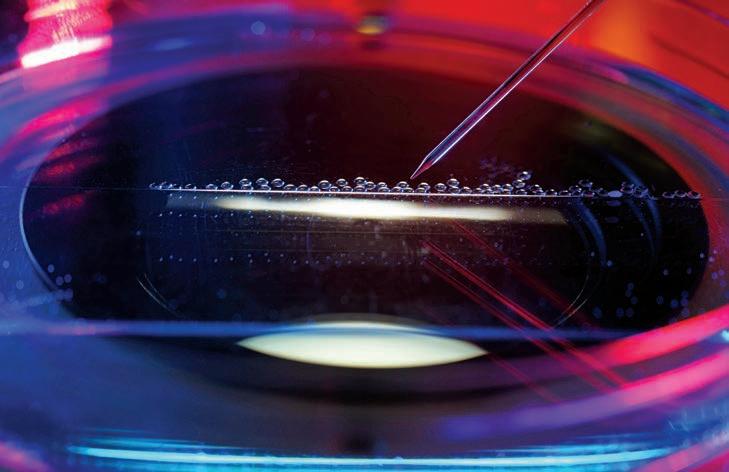
6 minute read
THE SKINNY
Some stem cells are derived from plants and flowers for skin-care products.
ighting the effects of aging, especially on your face, is no easy task. The hands of time, after all, are master sculptors of laugh lines and crow’s feet, and they’re often stubborn about changing their works of art.
Stem cells have become a buzzword in the skin-care industry for one, simple fact: They work. Yet not all stem cells are created equal. First, stem cells are derived from several sources. And while they’re all used in skin-care products, they don’t all work the same way—which is why you need to get educated about them so you can make wise buying decisions for your epidermis.
THE NATURE OF STEM CELLS
➜ No doubt you’re familiar with stem cells for their contribution to the medical field, as stem cells can regenerate and form different cells, which can then aid in counteracting numerous diseases. One stem cell, for instance, could turn into new tissue for the knee or the heart, depending on what signals it’s receiving from the body, says Rafael Gonzalez, Ph.D., vice president of research and development with DaVinci Biosciences in Yorba Linda, California.
So why add them to skin-care products? Anti-aging properties. “Just as conditions like heart disease are caused by inflammation in the body, so, too, is aging skin,” says John Sanderson, M.D., C.E.O. and chief science officer with Cellese Regenerative Therapeutics in Newport Beach, California, adding that this process has its own name: Inflammaging. Sun exposure, environmental toxins like smoking, gravity, and repetitive facial expressions all take their toll on facial skin, contributing to inflammaging. “Yet by using growth factors and compounds called cytokines from stem cells,” he says, “you can create an anti-inflammatory cocktail that helps repair aging skin and creates healthier, younger-looking skin.”
Stem cells on their own, though, aren’t shelf stable, meaning that they can’t be put directly into a jar—and, in another common misunderstanding, you can’t slather stem cells directly onto your skin. Instead, when companies say they’re using products from stem cells, they usually mean ingredients derived from stem cells, says Zoe Diana Draelos, M.D., consulting professor in dermatology at Duke University in Durham, North Carolina.
Most stem cells actually need to be purified, which requires them to be grown in Petri dishes in laboratories where they’re fed a diet high in proteins, amino acids, and glucose. When they have cell-to-cell contact, as they do in a Petri dish, they begin communicating with each other. As a result, released proteins called growth factors signal other cells and cause growth or changes to occur in your body, Gonzalez says. The end result is a cultured media, a sort of broth in a sense, that gets added to skin-care products.
THE PROOF IS IN THE PUDDING
➜ While stem cell-derived ingredients in skin-care products might sound like a marketing gimmick, there’s emerging proof they work. One of the most cited studies involves application of a topical skincare product with growth factors in which over 78 percent of individuals with sun-damaged skin showed improvements after 60 days. The topical also increased new formation of collagen, which gives skin its strength and structure, and thickens the epidermis, the skin’s outermost layer.
The evidence is so convincing, in fact, that just as there’s a food pyramid to help you select the healthiest foods for your body, there’s now a Skin Health and Beauty Pyramid, according to the Journal of Drugs in Dermatology. The pyramid consists of three layers, starting with a base of necessities for protection and repair (think SPF and antioxidants); a middle layer to help moisturize, exfoli-
medicalskin science
PHOTOGRAPHS BY GETTY IMAGES ate, and turn over cells with products like retinoids and alpha hydroxy acids; and a top layer for stimulation, which includes peptides and growth factors. “Think of that top layer as the finishing touch,” Draelos says.

SOURCING STEM CELLS
➜ So, where are companies getting stem cells for skin-care products? The three main sources include plants like those from sea fennel, edelweiss, gardenia, green tea, and lilac; animals (think calf amniotic and sheep placental stem cells); and people. The catch, though? “Not all stem cells work the same,” Gonzalez says. “The truth is that the most efficient, most effective stem cells for humans are those derived from people.”
To understand why, remember that the main task of growth factors is to send messages to other cells to stimulate growth, repair, and rejuvenation. They do this by using what Gonzalez describes as a lock-and-key system. Cells in your body have protein receptors, or locks. Meanwhile, other cells release proteins, or growth factors, which act as a key. Those proteins bind to receptors and activate cells to do their job correctly.
Stem cells, however, are different in every source, and although some growth factors may be similar between two sources, the fact that they’re not the same causes communication issues. “Growth factors from plants and animals can’t talk to human cells,” Sanderson says. It’s similar to when you try to use your cell phone in an area where your provider doesn’t have service. The signal ultimately fails.
Yet don’t discount stem cells from plants in particular, as they have the ability to aid your skin. “Plant growth factors won’t work on humans, but they do contain beneficial antioxidants for the skin,” Draelos says.
When skin-care companies extract stem cells from plants like raspberry or green tea, after all, they culture and centrifuge those stem cells. “In the end, you get a pure, reproducible source of antioxidants grown in an environmentally controlled chamber, removed from pollution and fertilizer,” Draelos says. Plus, because the stem cells are grown under standardized conditions, you know exactly how many antioxidants (for instance, catechins in green tea) a product contains, which has always been a problem in the past.
UNDERSTANDING HUMAN STEM CELLS
➜ In sourcing human stem cells for cosmetics, companies have a few options. They can grow stem cells in the lab, bioengineering them from either your stem cells or those of another person, umbilical cords, bone marrow, placental tissue or fat, or they can get them straight from fat tissue without any modifications.
That begs an obvious question: Is one better than the other when it comes to improving skin health? Experts agree that bioengineered seems to be best. “Bioengineered stem cells are pure stem cells without other contaminating cell types,” Gonzalez says. “They also have defined properties, which is why they may be a better source than ones straight from tissue.”
Trouble is, though, it’s difficult to know what you’re buying in a skin-care product. That’s why Gonzalez recommends doing your homework and contacting companies to ask where their stem cells come from.
Just don’t let price dictate your purchase, as more expensive doesn’t always translate into higher quality or efficacy. For instance, some products using stem cells from fat tissues are more expensive than ones using bone marrow, Sanderson says. “Active research and efforts are being made to understand the best profile of growth factors and the best concentration for skin rejuvenation. As we gain a better understanding, we may find that different concentrations and profiles work best for certain conditions. We need more studies but the good news is that the current products work,” says Dr. Gonzalez.
Granted, stem cell-derived ingredients in your skin-care regimen can’t change your chronological age. But with the right ones on your side, they’re one of the most potent tools for giving your facial skin new life.
Stem cell extraction.

GUTTER CREDIT Cold Case It’s holiday time! And we have you covered from head to mistletoe, from charitable gifts to Fashion Week must-haves. Meanwhile, Quantico breakout star Priyanka Chopra shines, millennial’s remake dating dynamics, and spa seekers find bliss with the Swiss.










